how to draw a maple tree without leaves
Maple trees are beautiful deciduous shade trees with leafy foliage. Maple trees have dark brown furrowed bark, small, winged fruits, and narrow reddish-brown twigs. Maple trees commonly have green lobed leaves that change their color to red, yellow, orange, and dark burgundy in the fall. The most identifiable feature of maple trees is their lobed leaves. Maples trees grow up to 150 ft. (45 m) tall.
Maple trees are flowering trees belonging to the genus Acer and the family Sapindaceae. Maples are closely related to horse chestnut trees.
This article is a complete guide to the most popular species of maple trees. Pictures and descriptions will help you identify the best maple trees for your garden landscape. You'll also find out about the best locations to grow maple trees in your backyard.
Maple Trees Facts
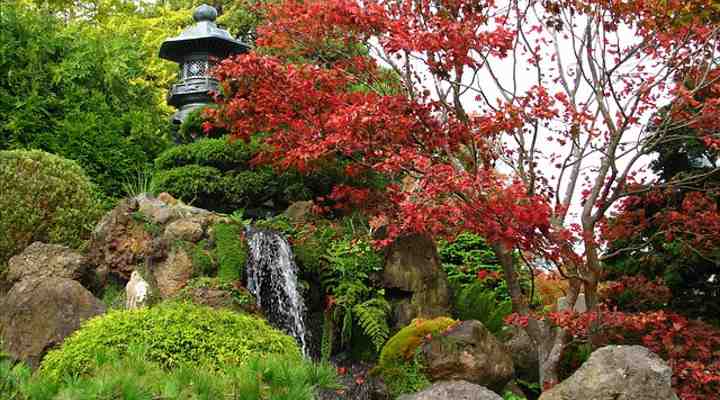
The ornamental maple tree provides stunning autumn color and there are many types to suit every garden
There are about 128 species of maple trees in the Acer plant genus. The two most common maples are the sugar maple (Acer saccharum) and the red maple (Acer rubrum). Other popular varieties of maple trees for gardens are the Amur Maple (Acer ginnala), Big Leaf Maple (Acer macrophyllum), and the Hedge Maple tree (Acer campestre).
The most famous product from maple trees is the sweet maple syrup made from the tree's sap. Although you can make syrup from any maple tree, it's only the sugar maple tree (Acer saccharum) that produces quality syrup.
Maple trees are also prized for their quality timber. Maple wood is a type of hardwood that is used to make baseball bats, bowling pins, pool cue shafts, and hardwood flooring. The decorative wood grain makes maple tree wood popular for making beautiful furniture.
The striking maple leaf—especially from the sugar maple tree—is undoubtedly the tree's most recognizable feature. A single stylized maple leaf with 11 points and deep indentations features prominently in the Canadian flag. The maple leaves are said to symbolize strength and endurance.
Maple Tree Leaves
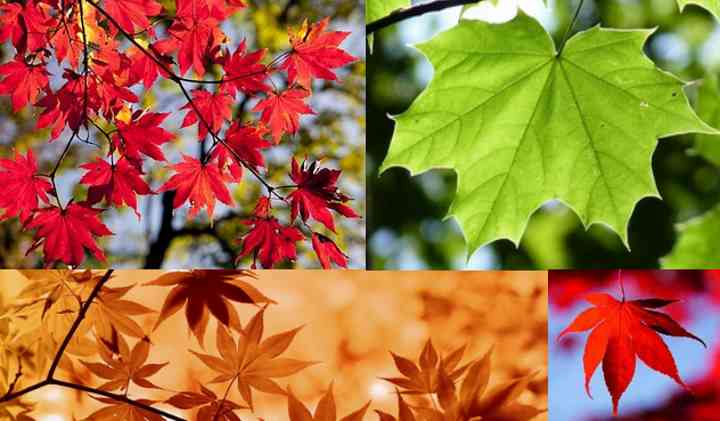
Maple leaf shape is the prominent way to help identify the type of maple tree
Maple tree leaves are lobed and have between three and nine lobes. The broad leaves have prominent veins. Many maple tree leaves have serrated lobes. The number of lobes, margin serration, depth of indentations, and leaf shape help to identify specific maple species.
For example, the sugar maple leaf has five serrated lobes. But comparing sugar maples with silver maples, you'll notice that silver maple leaves have deeper indentations than sugar maple leaves.
The indentation between the lobes of sugar maple leaves is U-shaped. However, red maple leaves have shallow V-shaped indentations between the lobes. Unlike sugar maples, red maple leaves have serrated margins and the indention between the lobes is not deep.
Maple tree leaves change their color in the fall and they become stunning hues of red, yellow, orange, and dark burgundy. In some species of maples, the tree leaves can be multiple colors at once—ranging from bright yellow to red wine color.
Maple leaves vs. sycamore leaves
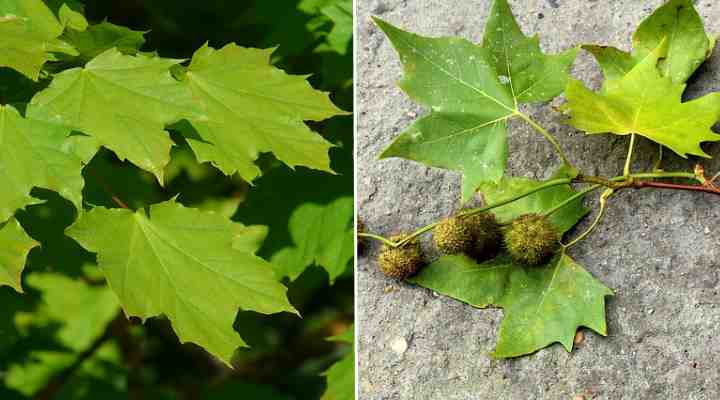
Some types of maple trees have similar leaves to sycamore trees. In the picture: maple leaves (left) and sycamore leaves (right)
Maple trees and sycamore trees have leaves that look similar. Generally, maple trees have leaves with deep indentations between their lobes whereas sycamore trees have leaves with shallow indentations. Maple tree leaves grow with an opposite leaf arrangement, whereas sycamore leaves grow alternately.
Maple Tree Bark
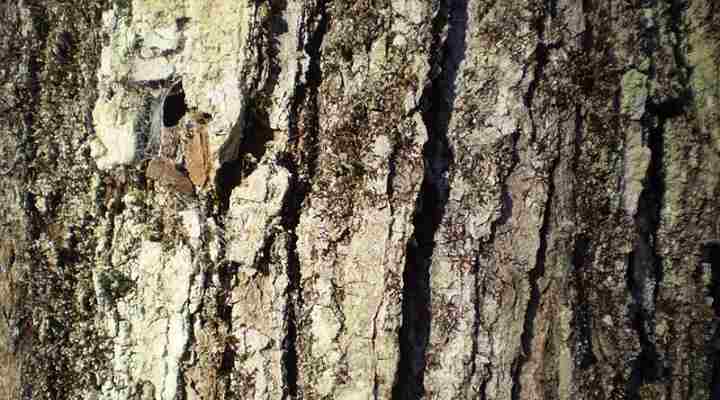
A close up picture of mature maple tree bark
Maple tree bark turns a dark brown color as the tree matures. Maple bark has wide strips running vertically up and down the trunk, separated by narrow grooves between the plates. Some species of maple trees have fewer furrows and less-pronounced fissures. Also, some maple tree species have smoother bark than others.
How to Identify Maple Trees
The best way to identify maple trees is by their leaves, bark, and fruit. Maple trees commonly have leaves with pointed lobes and with deep indentations between the lobes. The leaves are dark green color. The bark on maple trees starts smooth and gray before developing fissures and furrows.
Maple tree fruit looks like small wing-shaped leaves. The distinctive winged fruits are called samaras and contain a pair of seeds attached to a "wing" that carries the seed a long distance when it's windy.
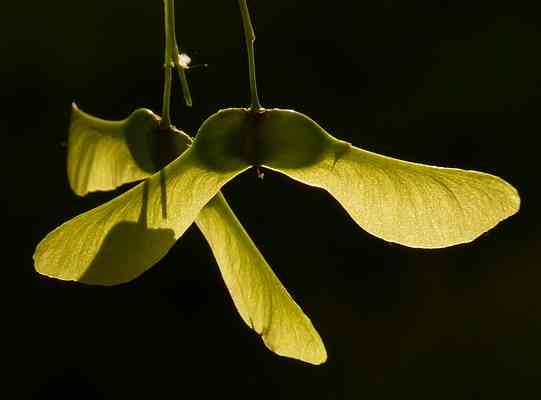
Maple tree fruit
Identify maple trees by their leaves: Maple tree leaves usually have three or five pointed lobes. Maple leaves have a deep green color that changes to yellow, red, burgundy, or orange in the fall. There are many variations between species of maple leaves.
Identify maple trees by their bark: Maple tree bark is generally gray-brown to reddish-brown. The vertical strips or plates on the trunk tend to peel and flake off. Silver maples have a flaky gray bark, whereas red maple trees have dark brown bark.
Sugar Maple Trees vs. Red Maple Trees
Red maple trees and sugar maple trees are the two of the most common species of maple. However, only the sugar maple tree is suitable for making sweet maple syrup. The sap of red maple tree is not as sweet as that of the sugar maple tree. The red maple tree is more of an ornamental garden landscape tree.
How can you tell the difference between sugar maple and red maple trees?
Sugar maple trees have leaves with smooth margins while red maple trees have leaves with serrated edges. The indentation between the lobes of sugar maple leaves is U shaped with a rounded base while the red maple trees have leaves with V shaped indentations.
Here are more details about sugar maple and red maple trees:
Sugar maple trees have dark green leaves that turn red, orange, or yellow in the fall. Sugar maple trees have 5-lobed leaves (3 large lobes and 2 small lobes). The space between the five pointed lobes of sugar maple leaves is U-shaped with a rounded base. The leaves of sugar maple trees are up to 8" (20 cm) long and wide.
Red maple trees have light-green leaves with a silvery underside. The leaves have three or five lobes with serrated edges. Red maple leaves don't have deep indentations between the lobes like sugar maple trees. Red maples have pale gray bark that is thinner than sugar maples. The leaves turn deep red in the fall.
Varieties of Maple Trees
Here are descriptions and pictures of the most common varieties of maple trees.
Sugar Maple Tree (Acer Saccharum)
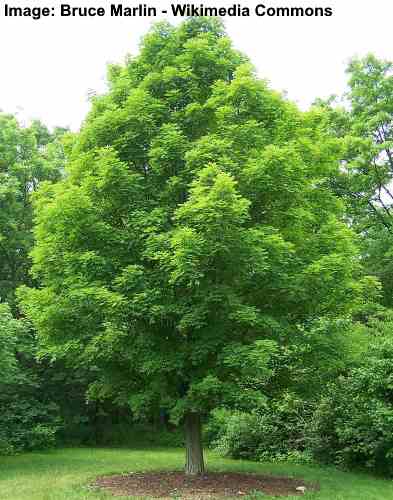
Sugar maple (Acer saccharum) tree
Sugar maple trees are large, fast-growing deciduous trees with straight trunks, rounded crowns, and spreading branches. Sugar maple trees grow to between 40 and 80 ft. (12 – 24 m) tall. This low-maintenance tree grows well in full sun or partial shade. Sugar maples trees thrive in zones 3 – 8.
The sugar maple is the principal source for maple syrup, and it's the national tree of Canada.
Maple tree leaves: Sugar maple leaves generally have five pointed lobes and deep green color. The large maple tree leaves turn a brilliant yellow, orange, or red color in the fall. Sugar maple tree leaves measure 3" and 6" (7 – 15 cm) long and wide.
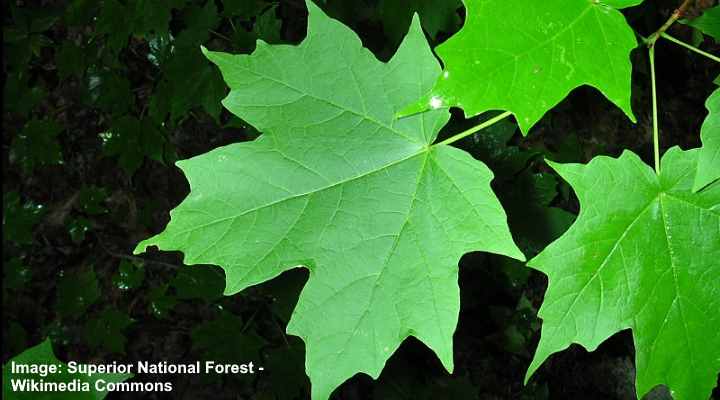
Sugar maple leaves
Maple tree bark: Sugar maple bark is a gray-brown color with long narrow grooves. As the tree matures, the bark starts to peel, giving the tree a shaggy look.
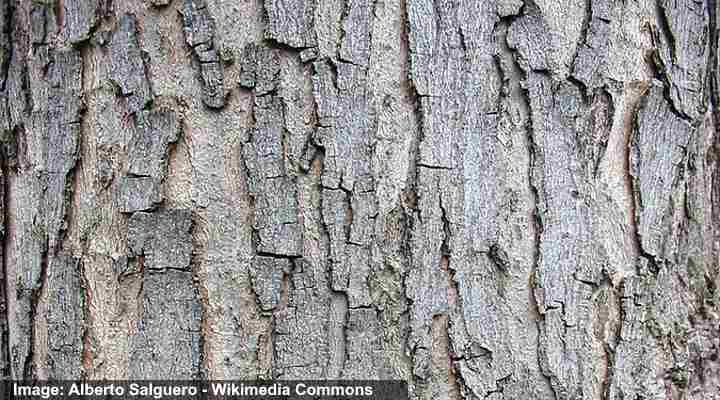
Sugar maple bark
Red Maple Tree (Acer Rubrum)
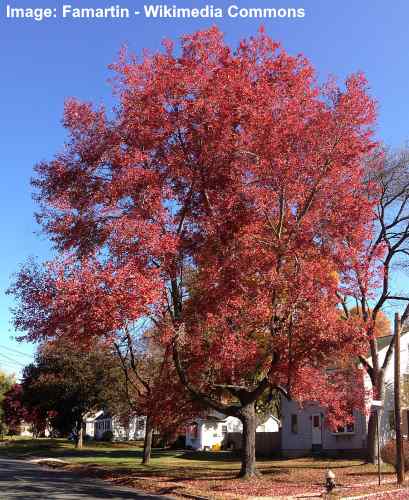
Red maple (Acer rubrum) tree
Red maple trees are stunning decorative landscape trees that have spectacular red foliage in the fall. Red maples have reddish flowers that appear in spring. The red maple leaves start as red color before turning green and then becoming yellow and red in the fall.
Red maples grow in North America and thrive in full sun or part shade. Fast-growing red maple trees grow to between 40 and 70 ft. (12 – 21 m). Grow red maples as landscape garden trees in zones 3 – 9.
Maple tree leaves: Red maple tree leaves are light green with white undersides. The leaves have between three and five lobes and are typically 2" – 4" (5 – 10 cm) wide and long. Unlike sugar maples and silver maples, red maple leaves have serrated margins and the indention between the lobes is not deep.
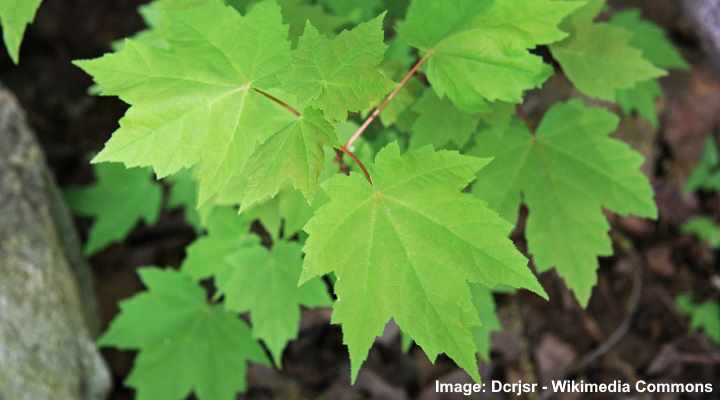
Red maple leaves
Maple tree bark: Red maple tree bark is thin, smooth, and gray when young and develops furrows with age.
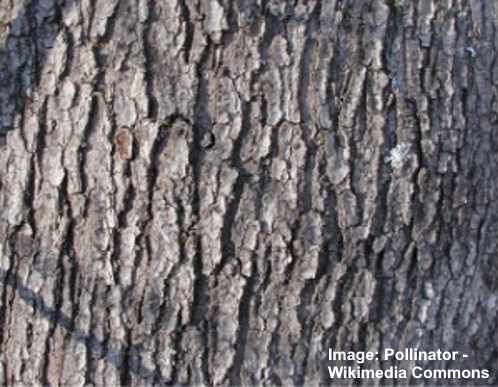
Bark of mature red maple
Japanese Maple Tree (Acer Palmatum)
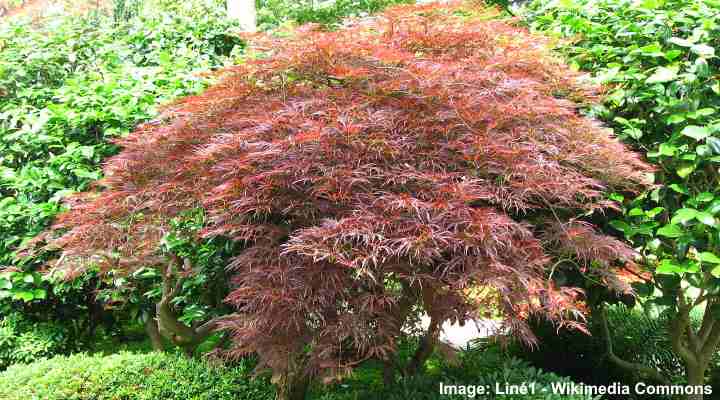
Japanese maple (Acer palmatum) tree
Japanese maple trees can grow up to 33 ft. (10 m) tall but some types of dwarf Japanese maples can look like small shrubby trees. The Japanese maple tree often grows as a small multi-stemmed tree that has a dome-like canopy or crown. Japanese maples have stunning foliage in the fall when their leaves turn yellow, bronze, or deep red color.
Japanese maple trees thrive in full sun to partial shade and grow in USDA zones 5 – 9.
Maple tree leaves: Japanese maple trees have palmately lobed leaves with five to nine serrated lobes. The leaves of the Japanese maple tree look like a hand with outstretched fingers. The light green leaves can grow up to 5" (12 cm) long.

The different Japanese maple cultivars vary in their leaf shape
Maple tree bark: Japanese maple tree bark is smooth and gray when young and develops furrows as it matures. The popular 'Sango-Kaku' cultivar has showy pink-colored bark, which looks stunning in winter landscapes.
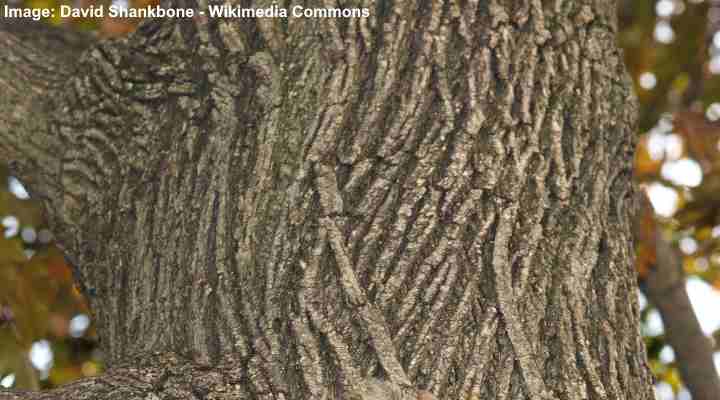
Japanese maple bark
Silver Maple Tree (Acer Saccharinum)
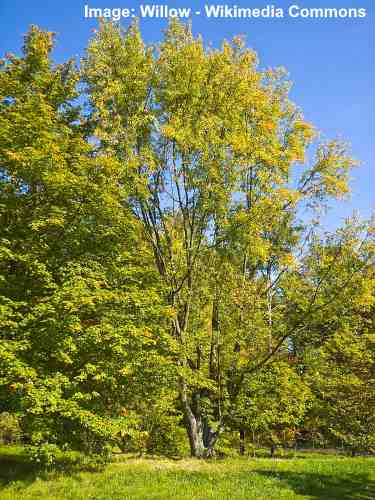
Silver maple (Acer saccharinum) tree
Silver maple trees are fast-growing deciduous trees that grow to between 50 and 80 ft. (15 – 25 m) with a spread of 36–49 ft. (11–15 m). Silver maple five-lobed leaves are green on one side and silver on the other. Silver maples thrive in zones 3 to 9.
Other names for the silver maple tree are creek maple, silverleaf maple, water maple, and swamp maple. Unlike other varieties of maple, silver maple tree leaves only have yellow-color in the fall.
Silver maple trees (Acer saccharinum) should not be confused with the sugar maple that has a similar botanical name (Acer saccharum).
Maple tree leaves: Silver maple tree leaves have five lobes with toothed edges. The leaves have deep indentations between the lobes. The silvery leaf undersides give this maple tree its common name.
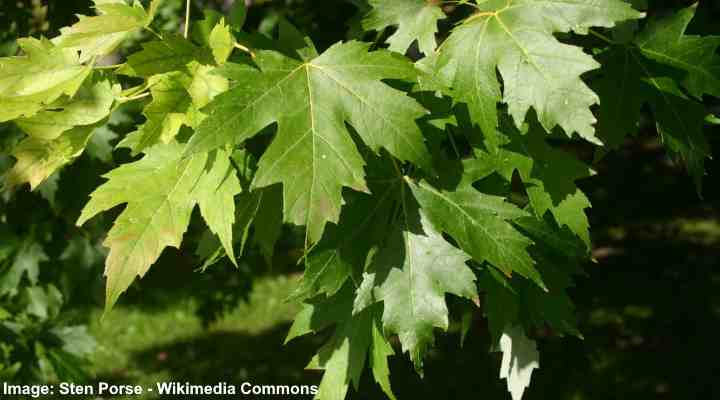
Silver maple leaves
Maple tree bark: Silver maple tree bark is smooth and silvery gray when young before becoming gray and shaggy as the tree matures.
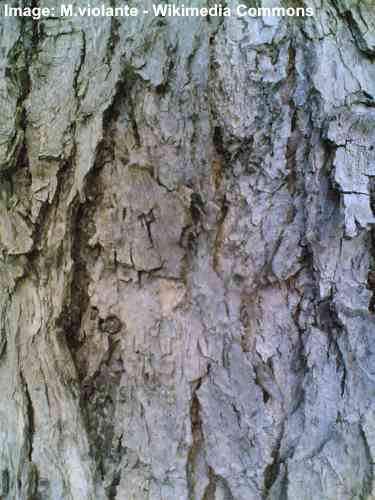
Silver maple bark
Boxelder Maple Tree (Acer Negundo)
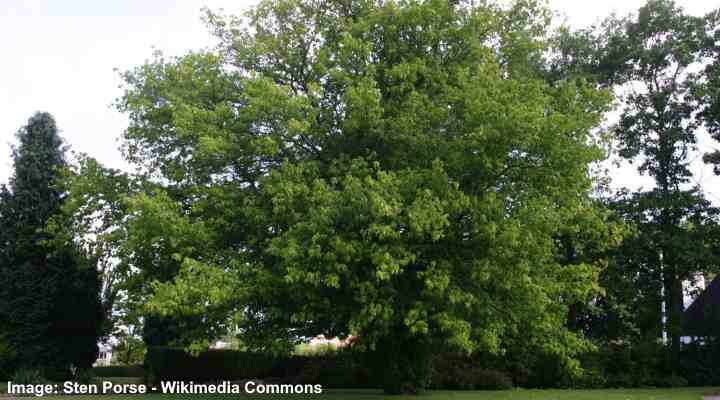
Boxelder maple (Acer negundo) tree
Boxelder maple trees are also called Manitoba maples or ash-leaved maples. The fast-growing tree grows up to 80 ft. (25 m) and sometimes has multiple trunks. Boxelder maples thrive in zones 2 to 9 and need to grow in full sun or partial shade.
Maple tree leaves: Boxelder maple tree leaves generally have three lobes that look like poison ivy leaves. Leaves are light green in spring and summer and turn yellow in the fall. The leaves have slightly serrate margins.
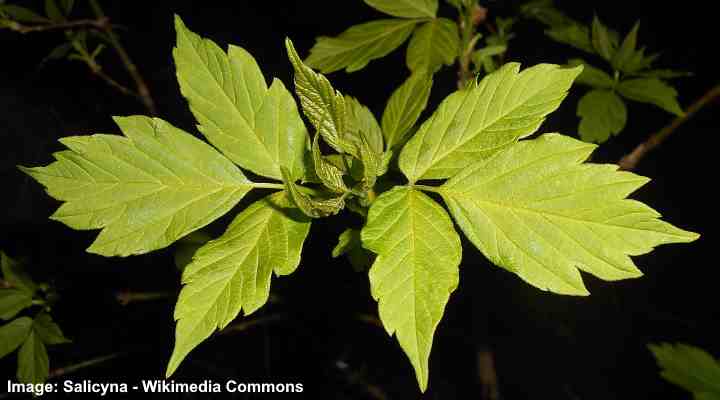
Boxelder maple leaves
Maple tree bark: Boxelder maple tree bark is pale gray to light brown with deep fissures that become scaly.
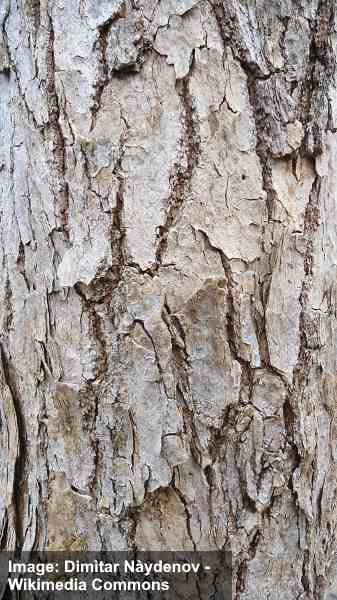
Boxelder maple bark
Norway Maple Tree (Acer Platanoides)
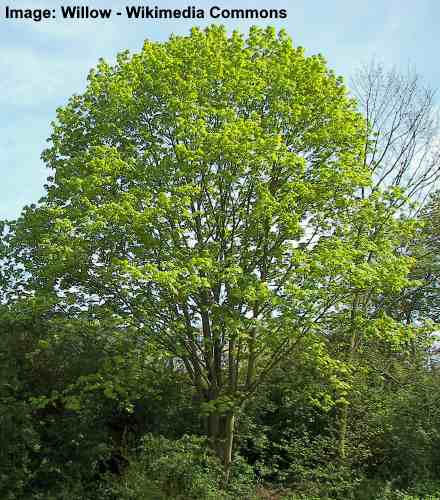
Norway maple (Acer platanoides) tree
Norway maple trees are deciduous trees with a broad, rounded crown and distinctive maple-type leaves. Native to Europe, Norway maples thrive in zones 4 to 7 and can grow in poor soil. Norway maples grow to between 65 and 100 ft. (20 – 30 m) tall.
Maple tree leaves: Norway maple tree leaves have five lobes and grow up to around 5" (12 cm) across. The lobed leaves have some teeth but generally have a smooth margin.

Norway maple leaves
Maple tree bark: Norway maple tree bark is gray-brown and has deep furrows as it matures.
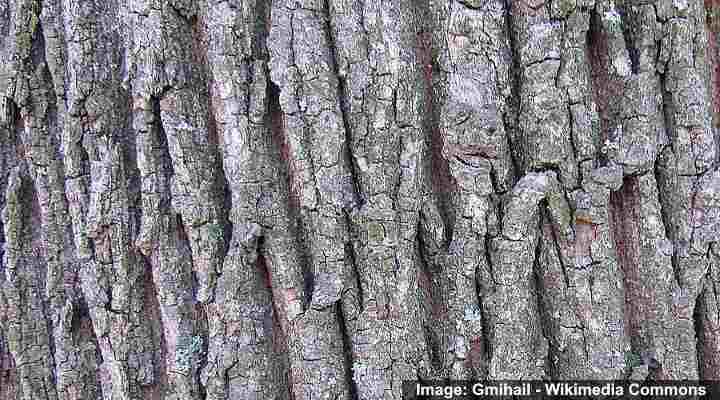
Norway maple bark
Paperbark Maple Tree (Acer Griseum)
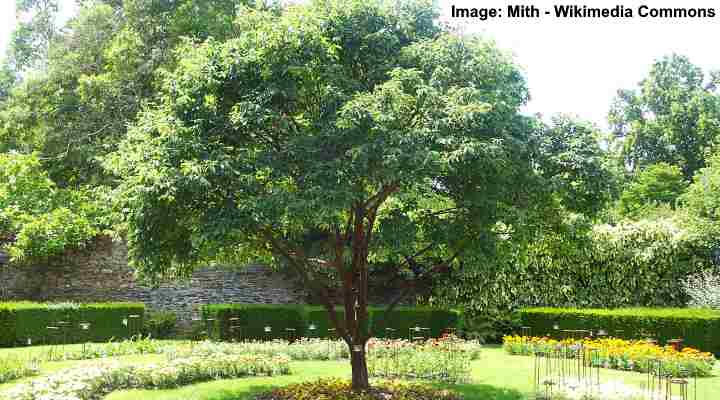
Paperbark maple (Acer griseum) tree
Paperbark maple trees have smooth, shiny, orange bark that peels off in strips. The papery bark can be in various shades of colors, including cinnamon, orange, and reddish-brown. Paperbark maples grow to between 20 and 30 ft. (6 – 9 m) tall and grow in zones 4 – 8.
Maple tree leaves: Paperbark maple tree leaves have three leaflets up to 4′ (10 cm) long. The maple leaves are dark green with blunted teeth on the margins.
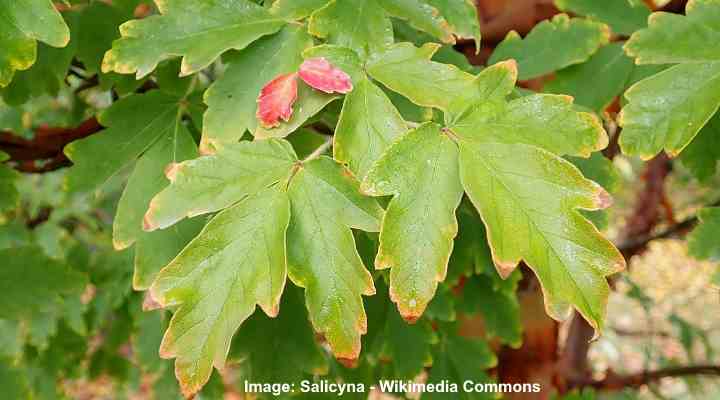
Paperbark maple leaves
Maple tree bark: Paperbark maple bark exfoliates with shards of thin, papery orange bark.
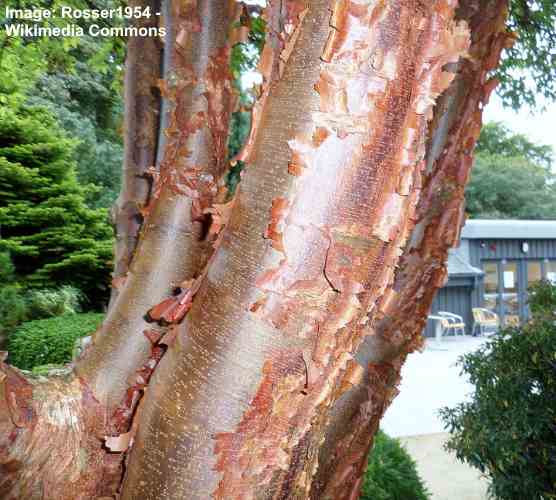
Paperbark maple bark
Sycamore Maple Tree (Acer pseudoplatanus)
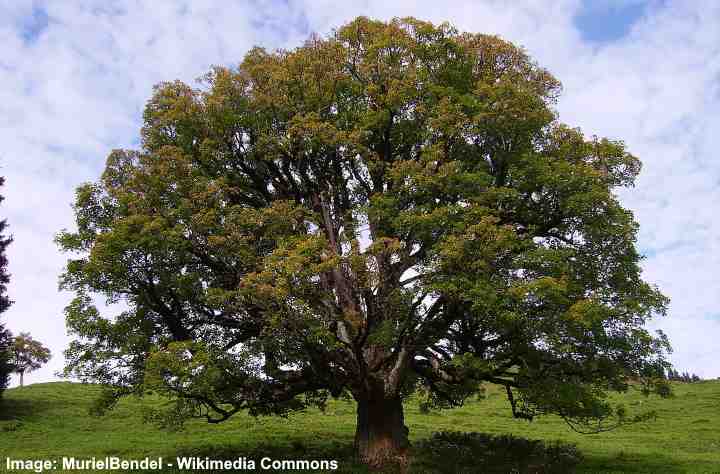
Sycamore maple (Acer pseudoplatanus) tree
Sycamore maple trees are large deciduous trees that grow in full sun. Sycamore maples have a rounded growth with foliage made up of large, broad leaves. Although called sycamores, these trees are not true sycamores but are members of the Acer genus.
Sycamore maple trees grow to between 40 and 60 ft. (12 – 18 m) and are suitable for USDA zones 4 – 7.
Maple tree leaves: Sycamore maple tree leaves are like sycamore leaves. The five-lobed leaves have a rounded shape with serrated margins. Leaves grow to between 4" and 10" (10 to 25 cm) long.
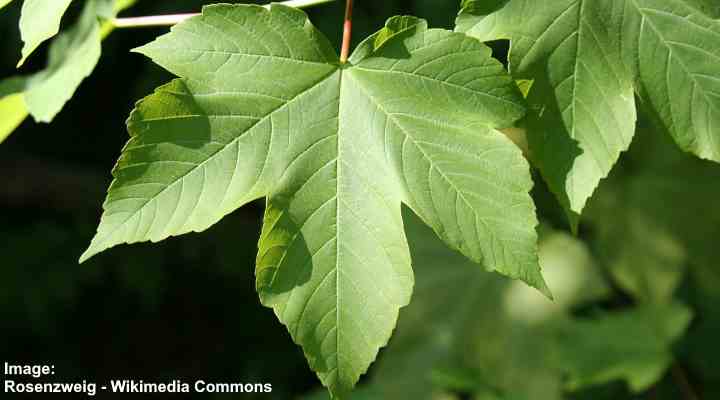
Sycamore maple leaves
Maple tree bark: Sycamore maple tree bark becomes rough and scaly as it matures. Under the exterior bark is a pinkish-brown inner bark.

Amur Maple Tree (Acer ginnala)
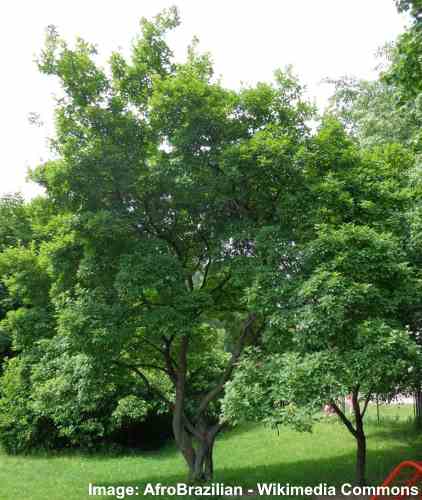
Amur maple (Acer ginnala) tree
Amur maple trees are large multi-stemmed shrubs or small trees. The Amur maple tree grows to between 10 and 32 ft. (3 – 10 m) and has a dense, rounded crown. Low-maintenance Amur maples thrive in zones 2 – 8 in full sun and poor soil.
Maple tree leaves: Amur maple tree leaves are 2" – 4" (5 – 10 cm) long with three or five lobes with toothed margins. Leaves turn red or yellow in the fall.
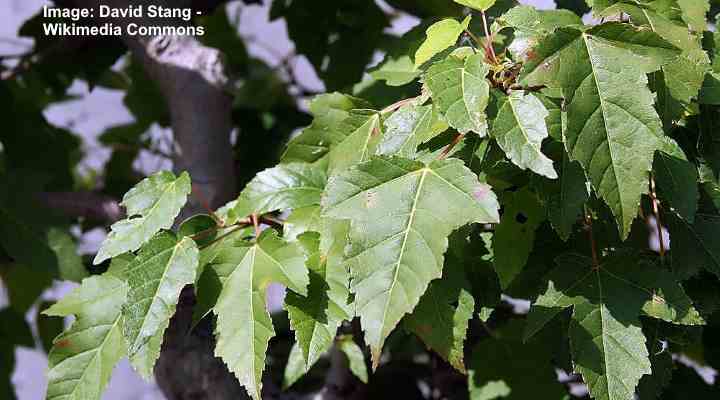
Amur maple leaves
Maple tree bark: Amur maple tree bark is smooth and gray that gradually become fissured as the tree matures.
Bigleaf Maple Tree (Acer macrophyllum)
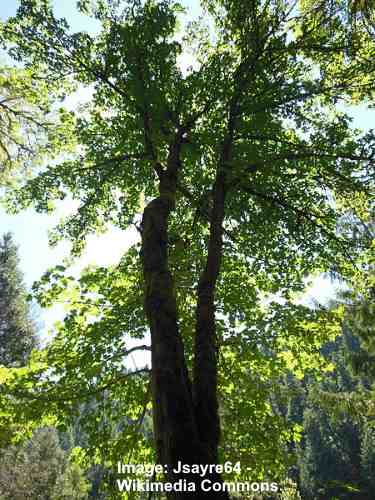
Bigleaf maple (Acer macrophyllum) tree
Bigleaf maple trees are native to North America and have the largest leaves on any maple species. Also called the Oregon maple, this giant tree grows up to 158 ft. (48 m) tall. The dark green foliage grows as a broad-rounded crown. Bigleaf maples thrive in zones 6 and 7.
Maple tree leaves: Bigleaf maple tree leaves are up to 12" (30 cm) across and have five lobes and deep indentations. Bigleaf maple leaves turn a spectacular golden yellow in the fall.
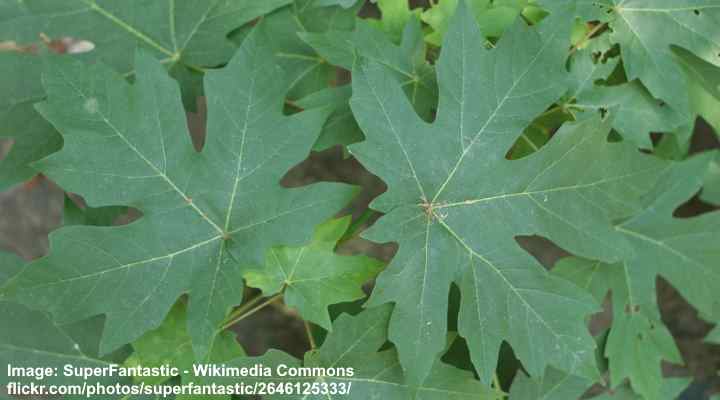
Bigleaf maple leaves
Maple tree bark: Bigleaf maple tree bark is reddish-brown with deep furrowing on mature trees.
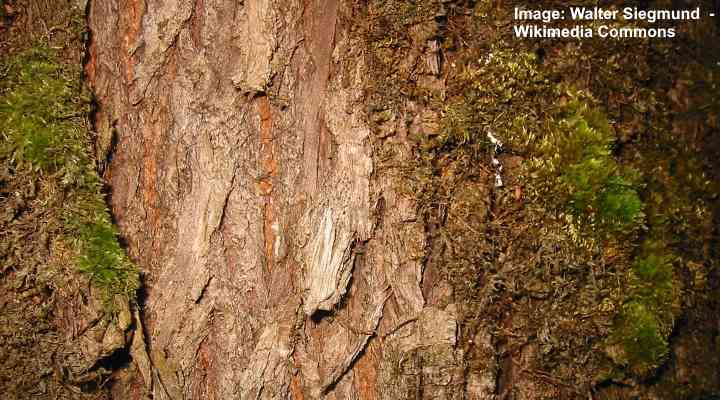
Bigleaf maple bark
Hedge Maple Tree (Acer campestre)
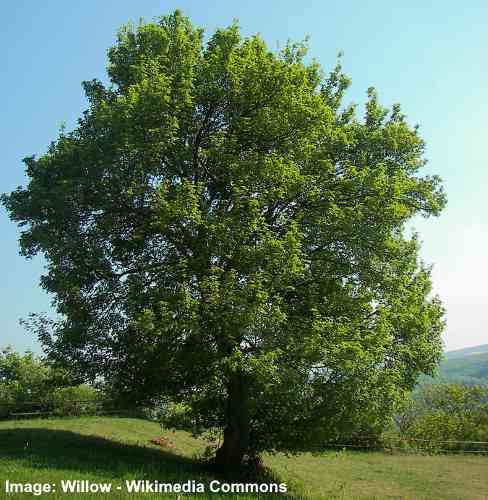
Hedge maple (Acer campestre) tree
Hedge maple trees grow in Europe and are medium-sized, fast-growing trees growing to between 50 and 80 ft. (15 – 25 m) tall. Also called the field maple, this deciduous tree is one of the last trees to turn color in the fall.
Maple tree leaves: Hedge maple tree leaves consist of three to five rounded lobes with a shiny, dark green surface. The leaves turn golden yellow in the fall.
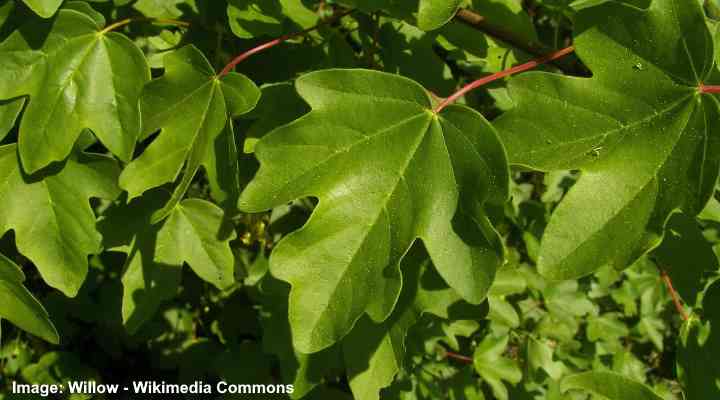
Hedge maple leaves
Maple tree bark: Hedge maple tree bark has deep fissures. The unique feature of maple tree bark is its soft texture, almost like cork.
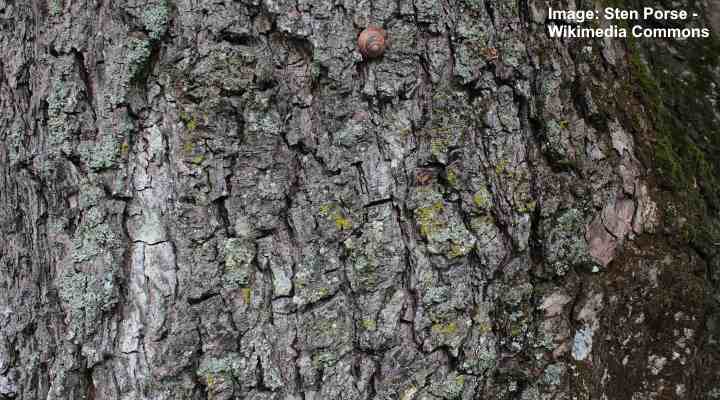
Hedge maple bark
Hornbeam Maple Tree (Acer carpinifolium)
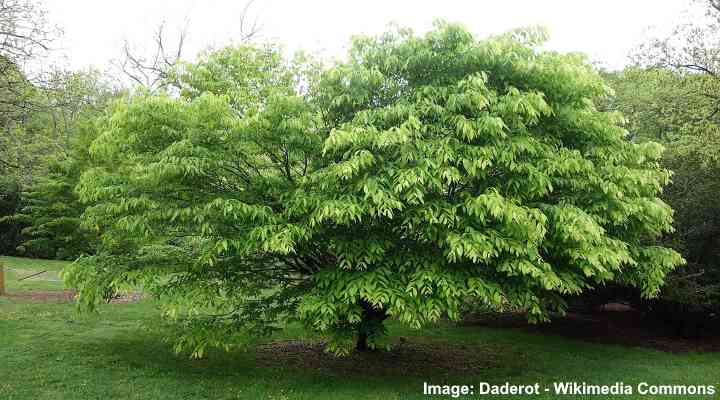
Hornbeam maple (Acer carpinifolium) tree
Hornbeam maple trees are small trees native to Japan. Hornbeam maples have short trunks with a rounded growth. Unlike other species of maples, hornbeam maples don't have lobed leaves. Hornbeam maple trees grow to between 20 and 30 ft. (6 – 9 m) tall and are hardy to zones 4 – 7.
Maple tree leaves: Hornbeam maple leaves are simple, unlobed leaves with serrated edges up to 6" (15 cm) long.
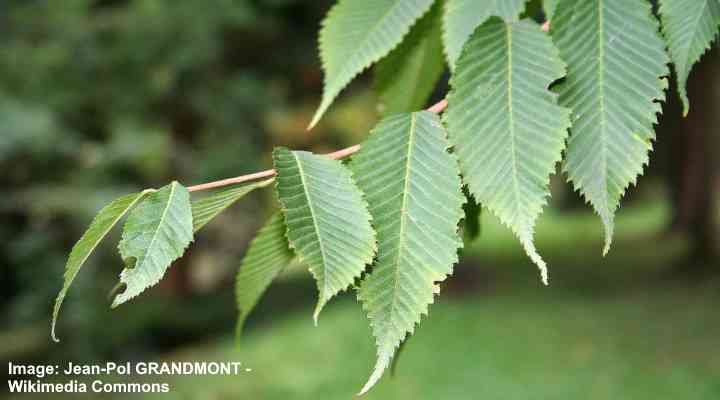
Hornbeam maple leaves
Maple tree bark: Hornbeam maple bark is dark gray to gray-brown that has a smooth feel.
Tatarian Maple Tree (Acer tataricum)
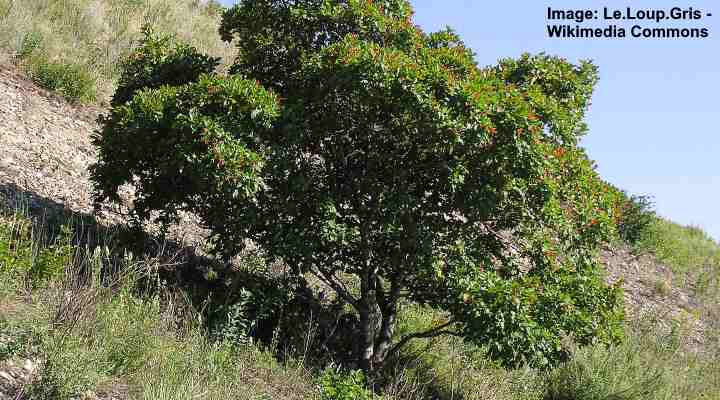
Tatarian maple (Acer tataricum) tree
Tartarian maple trees are small trees with slender trunks that grow up to 20 ft. (6 m) tall with a similar-sized spread. These European or Asian maples thrive in zones 3 to 8, growing in full sun or partial shade.
Tartarian maple tree leaves are unlobed or with three or five shallow lobes and ovately-shaped. The leaves are a medium green color that turns yellow or red in the fall.
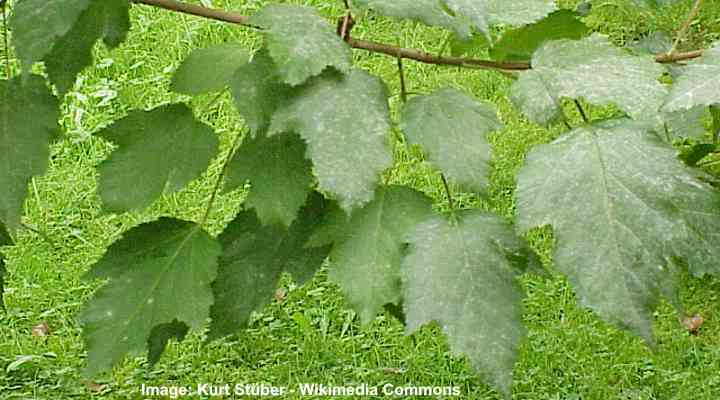
Tatarian maple leaves
Tartarian maple tree bark is thin and smooth in a pale brown color. The bark gradually becomes fissured as the plant matures.
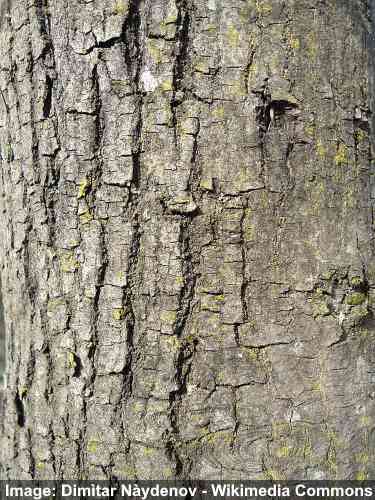
Tatarian maple bark
Vine Leaf Maple Tree (Acer cissifolium)
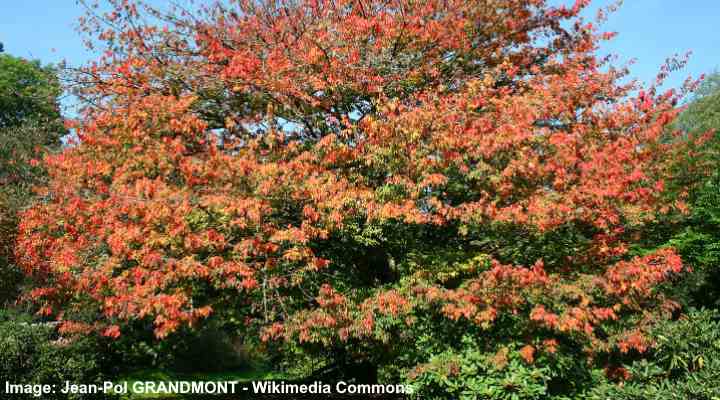
Vine leaf maple (Acer cissifolium) tree
Vine leaf maple trees are large shrub-like trees with a round top and dense foliage. As its common name suggests, the tree has leaves similar to spreading ivies. Vine leaf maples thrive in zones 5 to 8.
Vine leaf maple tree leaves are made up of three ovate leaflets with serrated edges. The medium green maple leaf color turns yellow to red in the fall.
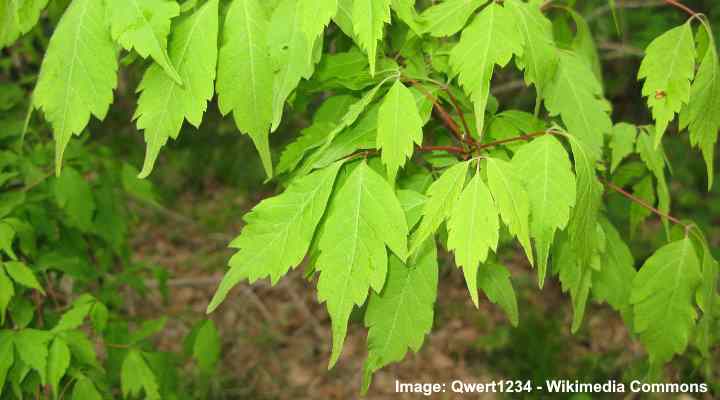
Vine leaf maple leaves
Vine leaf maple tree bark has smooth gray bark.
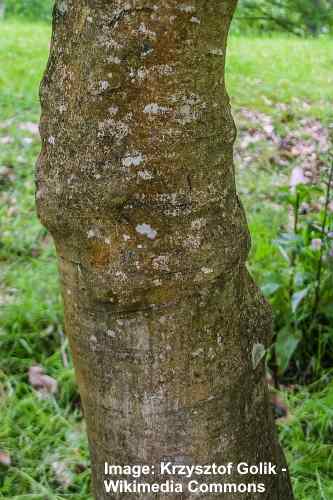
Vine leaf maple bark
Freeman Maple 'Autumn Blaze' Tree (Acer freemanii)

Freeman maple (Acer freemanii) 'Autumn Blaze' young tree
Freeman maples are stunning large maple trees with a large rounded grown, dense green foliage, and spectacular fall colors. The best example of a Freeman maple cultivar is the 'Autumn Blaze.' The 'Autumn Blaze' maple tree becomes a brilliant orange to crimson-red color in the fall. Freeman maple trees grow to between 50 and 60 ft. (15 – 18 m) in zones 3 to 8.
Freeman maple tree leaves have deep indentations between the lobes and are bright green color.
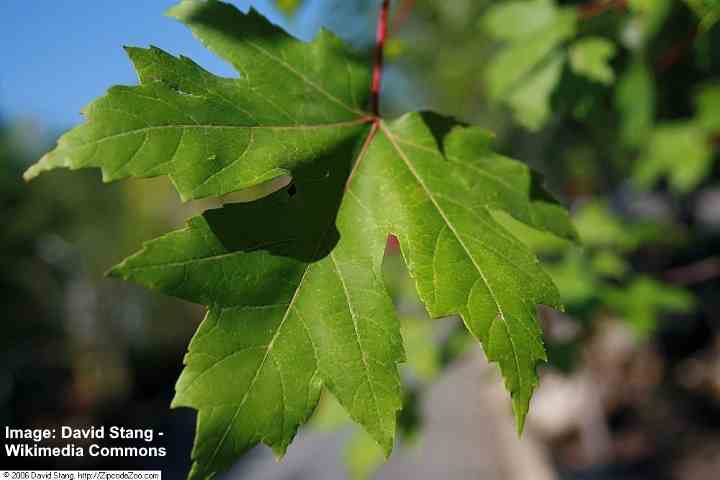
Freeman maple leaves
Freeman maple tree bark is smooth, thin, and gray that develops slight furrowing.
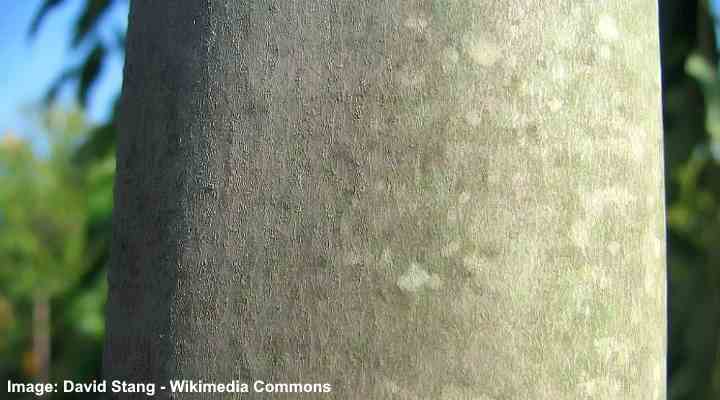
Freeman maple bark
Fullmoon Maple Tree (Acer shirasawanum)
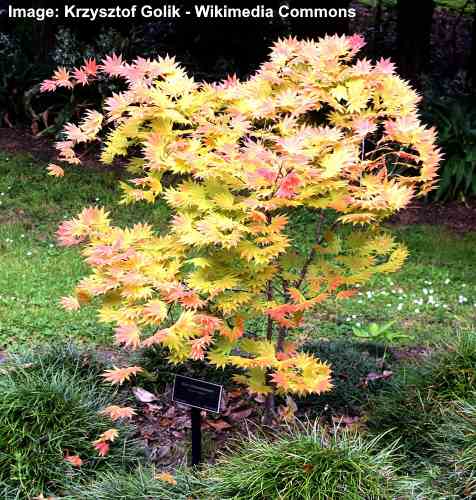
Fullmoon maple (Acer shirasawanum) 'Autumn Moon' tree
The fullmoon maple, or Shirasawa's maple, is a sizeable shrubby tree native to Japan. Fullmoon maples grow to between 26 and 50 ft. (8 – 15 m) tall. This species of maple is closely related to the Acer japonicum, which is also called the fullmoon maple tree or Amur maple.
Fullmoon maple tree leaves have nine to thirteen shallow lobes that give the leaf a rounded shape. The shallowly incised lobes have serrated edges. Leaves are medium green that turns golden orange to dark red in the fall.
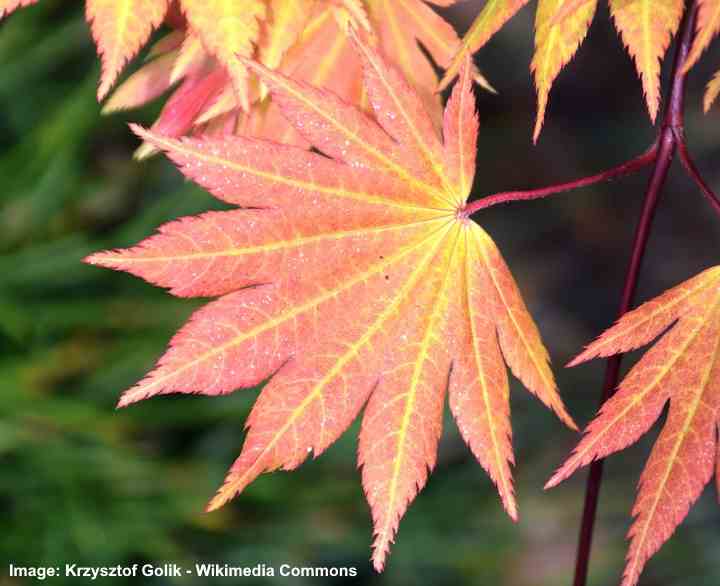
Fullmoon maple (Acer shirasawanum) 'Autumn Moon' leaves
Fullmoon maple bark is smooth and gray. Unlike many other maple species, the bark doesn't become fissured as the tree matures.
Discover the best Japanese maple trees to grow in the garden (with pictures).
Related articles:
- Varieties of Arborvitae Hedges, Trees, and Shrubs
- Amazing Types of Redbud Trees
- Hickory Trees: Types, Bark & Leaves – Identification Guide
Read Next
Source: https://leafyplace.com/maple-trees/
0 Response to "how to draw a maple tree without leaves"
Post a Comment